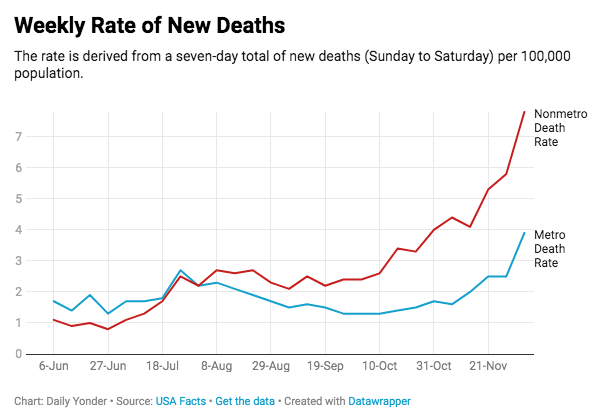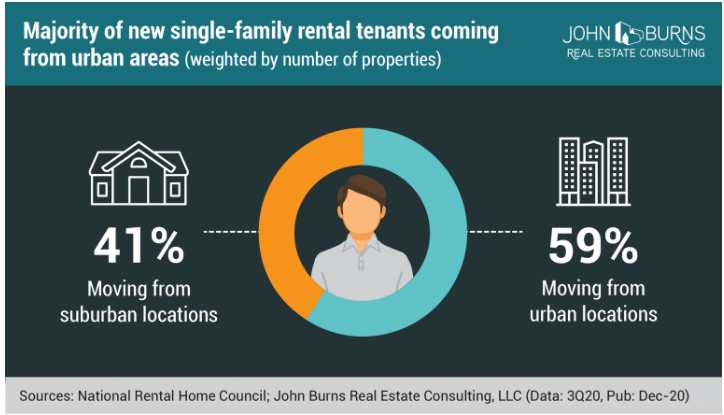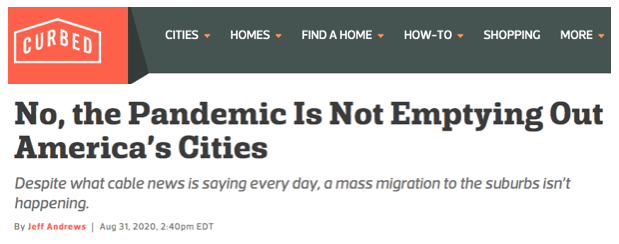Again: It’s anecdotes, not data that are fueling claims of an urban exodus due to Covid-19
The virus is now deadlier in the nation’s rural areas than it is in cities, undercutting the basis for the urban flight theory
Since the early days of the Coronavirus, the media has regularly trumpeted anti-city screeds, a kind of 21st Century echo of the “teeming tenements” indictment of the alleged unhealthiness of urban living in the 19th Century. In the Spring, the worst outbreaks were in the New York City metro area, which automatically led many to equate size and density with pandemic risk. As we’ve noted, the canonical story is generally the product of a reporter quoting some suburban real estate agent about a sale they’ve just made to someone who moved from the city. But as we’ve noted time and again, and yet again, the data don’t support the urban exodus theory.
Last week we saw another provocative headline about surging interest in suburban living, this time from usually reliable analysts at John Burns Real Estate Consulting (JBREC). They claimed that
We have all heard the tales of the current renter migration to the suburbs and even to the exurbs in some parts of the country. Until now, the migration story captivating the housing sector has been mostly anecdotal. But we now have proof! Our recent national survey of single-family rental (SFR) operators provides hard data confirming the migration movement that has been amplified by the pandemic.
. . .
59% of new SFR tenants are relocating from urban locations, with 41% of new tenants moving from already suburban locations.
We took a close look at the report. It’s single key data point is this: In their survey, 59 percent of those renting single family homes from survey participants were moving from urban areas.
We don’t have any reason to doubt the accuracy of that statistic, but without a little more context, its impossible to know what it means. Specifically, we don’t know if 59 percent of new residents coming from urban locations in higher than prior to the pandemic, or lower, or whether its influenced by seasonality or other factors. We followed up with JBREC’s Devyn Bachman, who confirmed that they don’t have data for the prior year, and telling us that the surge is based on anecdotal reports. The critical part of the story here is not the fraction of people moving from urban locations to suburbs, but whether that trend has shifted noticeably from prior years. And here, again, what we have is not data on such a shift, but simply anecdotes.
Its also worth keeping in mind that suburban single family rental housing is a relatively small segment of the market (most rentals are still multi-family). And Burns’ survey is a sample of larger scale, institutionally owned single-family landlords, which are an important and growing segment of the market, but a decided minority of single family landlords.
The pandemic is now far worse in rural reas
The foundation of the “urban flight” hypothesis is the notion that cites are vastly more risky than suburbs or rural areas: by fleeing, you can reduce your risk of getting Covid. The JBRE story pushing the urban flight hypothesis now seems a bit dated in light of the recent data on the spread of Covid-19. While it was true that cases and deaths per capita were higher in cities in the Spring, that’s no longer the case. In fact, the relationship between city size and Covid-19 mortality is now just the reverse, with the highest rates of deaths per capita in the nation’s most rural and least dense communities. Based solely on location factors, those who fled to the countryside earlier in the year are now statistically at much greater risk of being diagnosed with and dying from the disease that their urban counterparts. Our friends at the Daily Yonder have chronicled the grim shift in death rates:
 The nuance here seems to be that cities and large metro areas are more closely connected to the rest of the world, and while exposed to the Coronavirus first, and at a time when knowledge of the virus’s danger and preventative measures was limited, there was nothing about the urban environment that made its residents more susceptible to Covid. As the pandemic spread, more sparsely populated areas which were insulated from the virus primarily because of less frequent and robust connections to other places ceased to be refuges.
The nuance here seems to be that cities and large metro areas are more closely connected to the rest of the world, and while exposed to the Coronavirus first, and at a time when knowledge of the virus’s danger and preventative measures was limited, there was nothing about the urban environment that made its residents more susceptible to Covid. As the pandemic spread, more sparsely populated areas which were insulated from the virus primarily because of less frequent and robust connections to other places ceased to be refuges.
“Urban flight” as collective journalistic hysteria
NPR’s On the Media took a close look at these stories and concluded that the “urban flight” meme is both widespread and utterly false. In an incisive article at real estate website Curbed, Jeff Andrews attributes the popularity of these stories to biases of reporters:
Given that the media industry is concentrated in Manhattan — with another good chunk in San Francisco — journalists seem to be confusing the minor outbound migration from two ridiculously expensive areas with the double dose of demand happening across the country.
More insidiously, some members of the media are willing to peddle stories about nonexistent carnage in the streets, extrapolating that the cities — all cities, but especially the diverse, Democratic–led ones — are headed for inevitable collapse. And it’s hard not to separate that dark fantasy from a Republican talking point.
But, according to the data, it’s just not happening.
The idea that the pandemic has upended real estate markets and is triggering a flood of migrants to suburbs and rural areas has enormous appeal for reporters and their editors. Anecdotes to the contrary notwithstanding, there’s virtually no data to show this is happening.
City Beat is City Observatory’s occasional feature pushing back on stories in the popular media that we think are mistakenly beating up on cities.


